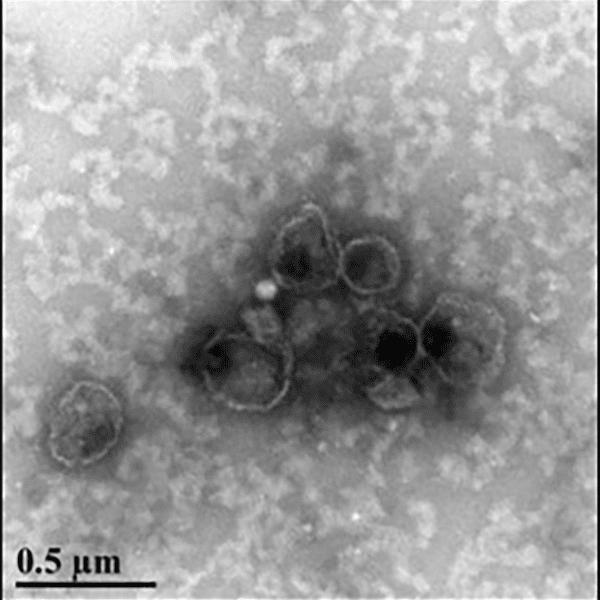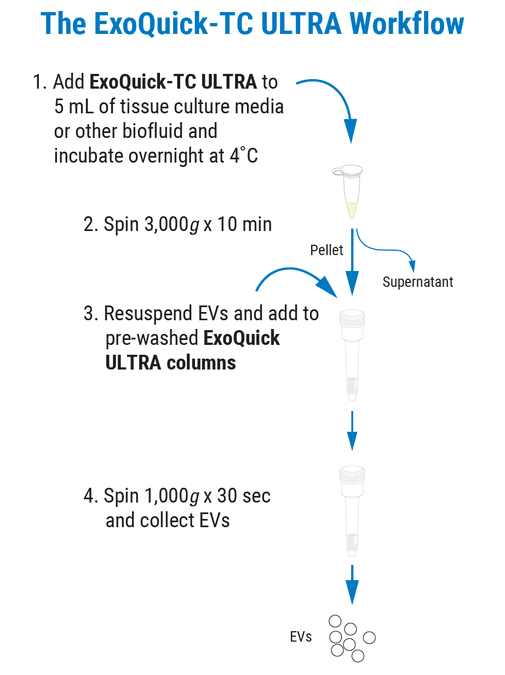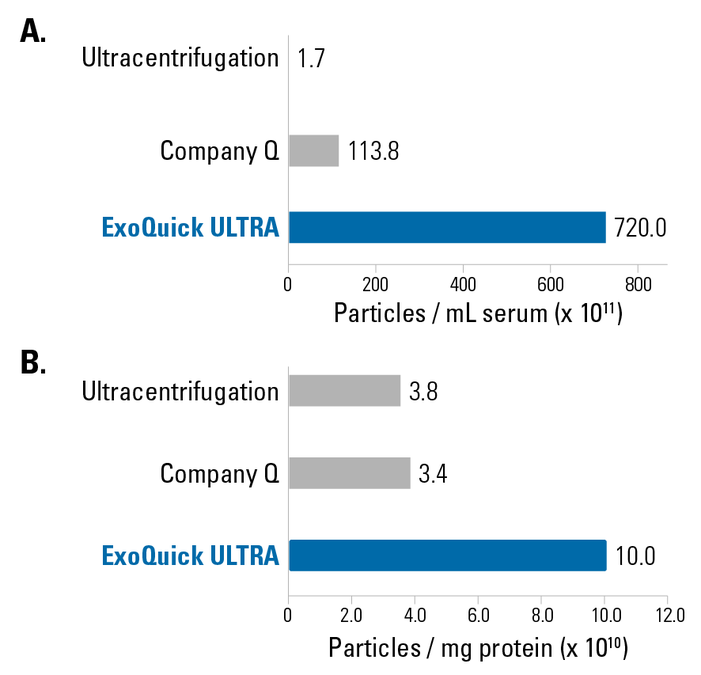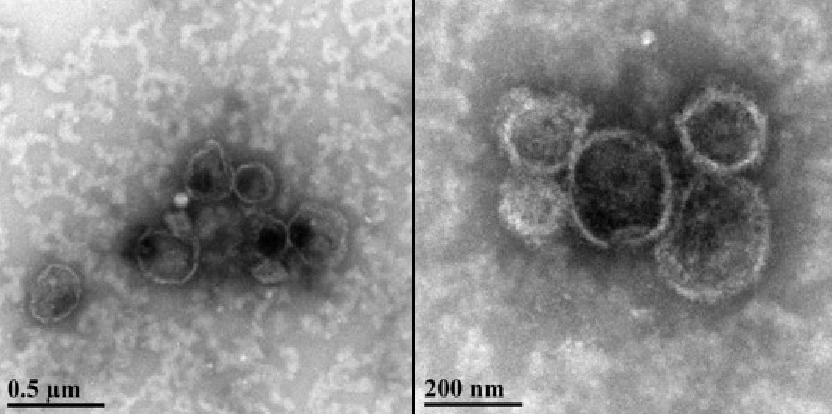ExoQuick-TC® ULTRA for Tissue Culture Media
- Even cleaner—reduces carry-over of albumins by 75% and immunoglobulins by 40% more than other methods, including ultracentrifugation and competitors’ kits
- Higher yields—isolate more EVs per normalized input volume than ultracentrifugation and competitors’ kits
- Better biomarker detection—see what you’ve been missing when you increase the sensitivity of EV biomarker detection by up to 11-fold (CD9) and 8-fold (CD81)
- Fast—requires less than 20-minutes of hands-on time, including a convenient column-based format for clean-up
- Cost-effective—save money with each reaction compared to how much you’ll spend using a competitor’s kit
Products
| Catalog Number | Description | Size | Price | Quantity | Add to Cart | |||
|---|---|---|---|---|---|---|---|---|
| EQULTRA-20TC-1 | ExoQuick® ULTRA EV Isolation Kit for Tissue Culture Media | 20 Reactions | $559 |
|
||||
Overview
Overview
Looking to isolate EVs from serum or plasma? Check out ExoQuick ULTRA.
Uncompromising EV isolation delivers higher yields and cleaner preps
Leveraging our years of exosome expertise, the SBI team has pushed ExoQuick-TC extracellular vesicle (EV) isolation technology to new peaks of performance with ExoQuick-TC ULTRA for tissue culture media and most biofluids. While many EV isolation methods force you to choose between high yields, easy protocols, clean preps, and low costs, ExoQuick-TC ULTRA is able to deliver on all these fronts for trade-off free EV preparation.
Looking to isolate EVs from serum or plasma? Check out ExoQuick ULTRA.

Important for intercellular communication in both normal physiology as well as disease states such as cancer, EV biology is rapidly growing field. However, obtaining EVs for in vivo and ex vivo studies can be challenging. Ultracentrifugation has been considered the gold standard for exosome isolation, but the method is time-consuming, requires large sample volume inputs and access to specialized equipment. Additionally, UC doesn't isolate the cleanest exosome preparations it once was thought to produce. Other commercial kit are faster and easier than ultracentrifugation, but still include carryover protein that can cause over-estimation of EV amount and that can interfere with protein-sensitive studies such as mass spectrometry.
Fortunately, the SBI team is never content with good enough and has continued to improve our ExoQuick technology. Now, with our newest generation of ExoQuick-TC—ExoQuick-TC ULTRA—you no longer have to make the trade-off between yield, purity, speed, a simple protocol, and price. From as little as 5 mL of tissue culture media or other biofluid and our ExoQuick-TC ULTRA kit, you can isolate high-quality EVs for a wide range of downstream applications such as such as western blotting, mass spectrometry, NGS sequencing, exosome labeling, and in vivo/ex vivo exosome delivery.
- Even cleaner—reduces carry-over of albumins by 75% and immunoglobulins by 40% more than other methods, including ultracentrifugation and competitors’ kits
- Higher yields—isolate more EVs per normalized input volume than ultracentrifugation and competitors’ kits
- Better biomarker detection—see what you’ve been missing when you increase the sensitivity of EV biomarker detection by up to 11-fold (CD9) and 8-fold (CD81)
- Fast—requires less than 20-minutes of hands-on time, including a convenient column-based format for clean-up
- Cost-effective—save money with each reaction compared to how much you’ll spend using a competitor’s kit
Each ExoQuick-TC ULTRA Kit for tissue culture media and most fluids comes with enough ExoQuick-TC ULTRA reagent and convenient, pre-packed columns to complete 20 reactions*.
*1 reaction is defined as 5 mL of tissue culture media or other biofluid precipitated using ExoQuick-TC ULTRA
References
How It Works
How It Works
How to get to ULTRA-clean EV preps
The ExoQuick-TC ULTRA protocol is quick and easy, requiring only 10-minutes of hands-on time.
- Add ExoQuick-TC ULTRA to 5 mL of tissue culture media or other biofluid and incubate overnight at 4°C
- Collect EVs by spinning at 3,000g for 10 minutes
- Resuspend EVs and add to pre-washed ExoQuick-TC ULTRA columns
- Spin 1,000g x 30 sec and collect EVs—they are now ready to use
Supporting Data
Supporting Data
See how well ExoQuick ULTRA delivers
Figure 1. ExoQuick-TC ULTRA delivers high yields of clean exosomes. Comparison of different EV isolation methods via Western blot shows that the ExoQuick-TC ULTRA prep contains the highest levels of the exosome-specific marker CD63 and the lowest levels of the carryover protein albumin. In contrast, the prep from Company Q appears to be primarily albumin, and even the sample prepared using ultracentrifugation contains considerably higher levels of both albumin and IgGH. Each lane was loaded with 4 μg of total protein.
Figure 2. Fluorescent nanoparticle tracking analysis (fNTA) demonstrates the high EV yields delivered by ExoQuick ULTRA compared to Ultracentrifugation. Comparison of different isolation methods on EV yields by both volume of input serum (per mL, A) and amount of input serum protein (per mg as measured by fluorometric Qubit protein assay, B). Particle number was measured using fNTA, a technique which specifically detects EVs (see how to use fNTA to measure EV concentration at our ExoGlow-NTA page).
Figure 3. EVs isolated using ExoQuick ULTRA display typical EV morphology. Transmission electron micrographs of EVs isolated from human serum using ExoQuick. The same sample is shown at two different magnifications. Multiple vesicles with typical EV morphology can be seen in each image.
FAQs
Documentation
Citations
Related Products
Products
| Catalog Number | Description | Size | Price | Quantity | Add to Cart | |||
|---|---|---|---|---|---|---|---|---|
| EQULTRA-20TC-1 | ExoQuick® ULTRA EV Isolation Kit for Tissue Culture Media | 20 Reactions | $559 |
|
||||
Overview
Overview
Looking to isolate EVs from serum or plasma? Check out ExoQuick ULTRA.
Uncompromising EV isolation delivers higher yields and cleaner preps
Leveraging our years of exosome expertise, the SBI team has pushed ExoQuick-TC extracellular vesicle (EV) isolation technology to new peaks of performance with ExoQuick-TC ULTRA for tissue culture media and most biofluids. While many EV isolation methods force you to choose between high yields, easy protocols, clean preps, and low costs, ExoQuick-TC ULTRA is able to deliver on all these fronts for trade-off free EV preparation.
Looking to isolate EVs from serum or plasma? Check out ExoQuick ULTRA.

Important for intercellular communication in both normal physiology as well as disease states such as cancer, EV biology is rapidly growing field. However, obtaining EVs for in vivo and ex vivo studies can be challenging. Ultracentrifugation has been considered the gold standard for exosome isolation, but the method is time-consuming, requires large sample volume inputs and access to specialized equipment. Additionally, UC doesn't isolate the cleanest exosome preparations it once was thought to produce. Other commercial kit are faster and easier than ultracentrifugation, but still include carryover protein that can cause over-estimation of EV amount and that can interfere with protein-sensitive studies such as mass spectrometry.
Fortunately, the SBI team is never content with good enough and has continued to improve our ExoQuick technology. Now, with our newest generation of ExoQuick-TC—ExoQuick-TC ULTRA—you no longer have to make the trade-off between yield, purity, speed, a simple protocol, and price. From as little as 5 mL of tissue culture media or other biofluid and our ExoQuick-TC ULTRA kit, you can isolate high-quality EVs for a wide range of downstream applications such as such as western blotting, mass spectrometry, NGS sequencing, exosome labeling, and in vivo/ex vivo exosome delivery.
- Even cleaner—reduces carry-over of albumins by 75% and immunoglobulins by 40% more than other methods, including ultracentrifugation and competitors’ kits
- Higher yields—isolate more EVs per normalized input volume than ultracentrifugation and competitors’ kits
- Better biomarker detection—see what you’ve been missing when you increase the sensitivity of EV biomarker detection by up to 11-fold (CD9) and 8-fold (CD81)
- Fast—requires less than 20-minutes of hands-on time, including a convenient column-based format for clean-up
- Cost-effective—save money with each reaction compared to how much you’ll spend using a competitor’s kit
Each ExoQuick-TC ULTRA Kit for tissue culture media and most fluids comes with enough ExoQuick-TC ULTRA reagent and convenient, pre-packed columns to complete 20 reactions*.
*1 reaction is defined as 5 mL of tissue culture media or other biofluid precipitated using ExoQuick-TC ULTRA
References
How It Works
How It Works
How to get to ULTRA-clean EV preps
The ExoQuick-TC ULTRA protocol is quick and easy, requiring only 10-minutes of hands-on time.
- Add ExoQuick-TC ULTRA to 5 mL of tissue culture media or other biofluid and incubate overnight at 4°C
- Collect EVs by spinning at 3,000g for 10 minutes
- Resuspend EVs and add to pre-washed ExoQuick-TC ULTRA columns
- Spin 1,000g x 30 sec and collect EVs—they are now ready to use
Supporting Data
Supporting Data
See how well ExoQuick ULTRA delivers
Figure 1. ExoQuick-TC ULTRA delivers high yields of clean exosomes. Comparison of different EV isolation methods via Western blot shows that the ExoQuick-TC ULTRA prep contains the highest levels of the exosome-specific marker CD63 and the lowest levels of the carryover protein albumin. In contrast, the prep from Company Q appears to be primarily albumin, and even the sample prepared using ultracentrifugation contains considerably higher levels of both albumin and IgGH. Each lane was loaded with 4 μg of total protein.
Figure 2. Fluorescent nanoparticle tracking analysis (fNTA) demonstrates the high EV yields delivered by ExoQuick ULTRA compared to Ultracentrifugation. Comparison of different isolation methods on EV yields by both volume of input serum (per mL, A) and amount of input serum protein (per mg as measured by fluorometric Qubit protein assay, B). Particle number was measured using fNTA, a technique which specifically detects EVs (see how to use fNTA to measure EV concentration at our ExoGlow-NTA page).
Figure 3. EVs isolated using ExoQuick ULTRA display typical EV morphology. Transmission electron micrographs of EVs isolated from human serum using ExoQuick. The same sample is shown at two different magnifications. Multiple vesicles with typical EV morphology can be seen in each image.





